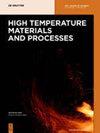刀具横移速度对2195-T8铝锂合金搅拌摩擦焊接接头接头残留及力学性能的影响
IF 1.6
4区 材料科学
Q4 MATERIALS SCIENCE, MULTIDISCIPLINARY
引用次数: 0
摘要
摘要AA2195-T8铝锂合金板材采用搅拌摩擦焊(FSW)焊接,工具转速为1000 rpm和刀具横向速度(TS)为100–400 在三种对接表面条件下,即(1)未进行对接表面处理,(2)对接表面铣削,以及(3)板上焊珠。综合研究了焊接热输入和对接表面条件对2195-T8铝锂合金搅拌摩擦焊接头残余线(JLR)和力学性能的影响。在2195-T8 FSW接头的搅拌区,存在由氧化铝颗粒阵列和初始对接表面产生的微裂纹组成的JLR,并且随着TS的增加,JLR的形态将从光滑演变为锯齿状。此外,随着TS的增加(即焊接热输入的减少),JLR会降低2195-T8 FSW接头的抗拉强度,接头沿JLR过早断裂。2195-T8 FSW接头的断裂模式被认为是由JLR强度(S JLR)和最低硬度区强度(S LHZ)之间的较低值决定的,并且JLR倾向于在较低的焊接热输入下的断裂路径。此外,发现对接表面处理(焊接前磨掉氧化层)能够使2195-T8 FSW接头中的JLR不那么明显,从而改善S JLR,而无法避免沿JLR断裂。本文章由计算机程序翻译,如有差异,请以英文原文为准。
Effect of tool traverse speed on joint line remnant and mechanical properties of friction stir welded 2195-T8 Al–Li alloy joints
Abstract AA2195-T8 Al–Li alloy plates were welded by friction stir welding (FSW) at tool rotational speed of 1,000 rpm and tool traverse speeds (TS) of 100–400 mm·min−1 under three types of butting surface conditions, i.e., (1) without butting surface treatment, (2) butting surface milled, and (3) bead-on-plate welding. The effect of welding heat input and butting surface condition on joint line remnant (JLR) and mechanical properties of friction stir welded 2195-T8 Al–Li alloy was investigated comprehensively. In the stir zone of 2195-T8 FSW joints, there exists JLR composed of alumina-particle arrays and microcracks generated from the initial butting surface, and the morphology of JLR would evolve from smooth to serrate as TS increases. Moreover, as TS increases (i.e., the welding heat input decreases), JLR deteriorates the tensile strength of the 2195-T8 FSW joints, with joints prematurely fracturing along JLR. The fracture mode of 2195-T8 FSW joints was considered to be determined by the lower one between strength of JLR (S JLR) and strength of the lowest hardness zone (S LHZ), and JLR tends to be the fracture path at lower welding heat input. Furthermore, butting surface treatment (milling off oxide layer prior to welding) was found to be able to make the JLR in the 2195-T8 FSW joints less distinct and thus improve S JLR, while fracture along JLR could not be avoided.
求助全文
通过发布文献求助,成功后即可免费获取论文全文。
去求助
来源期刊

High Temperature Materials and Processes
工程技术-材料科学:综合
CiteScore
2.50
自引率
0.00%
发文量
42
审稿时长
3.9 months
期刊介绍:
High Temperature Materials and Processes offers an international publication forum for new ideas, insights and results related to high-temperature materials and processes in science and technology. The journal publishes original research papers and short communications addressing topics at the forefront of high-temperature materials research including processing of various materials at high temperatures. Occasionally, reviews of a specific topic are included. The journal also publishes special issues featuring ongoing research programs as well as symposia of high-temperature materials and processes, and other related research activities.
Emphasis is placed on the multi-disciplinary nature of high-temperature materials and processes for various materials in a variety of states. Such a nature of the journal will help readers who wish to become acquainted with related subjects by obtaining information of various aspects of high-temperature materials research. The increasing spread of information on these subjects will also help to shed light on relevant topics of high-temperature materials and processes outside of readers’ own core specialties.
 求助内容:
求助内容: 应助结果提醒方式:
应助结果提醒方式:


